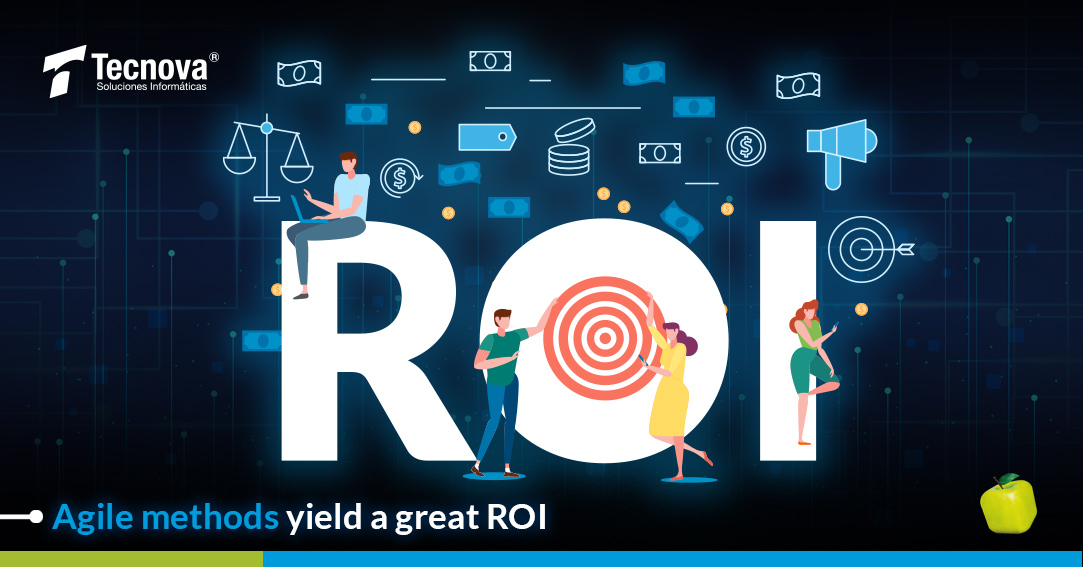Why do agile methods give a fast ROI?

Resorting to agile methods for project development has long existed. However, technological advances and increased customer demands make the trend agile. In addition to the benefits of using this working methodology, which in Tecnova we talk about in this post, it is important to highlight the rapid ROI that comes with using agile methods.
What is ROI?
According to Infoq, Return on Investment (ROI) “is defined as the amount of money earned or lost in an investment relative to the resources invested”. Expected ROI is a very important deciding factor in adopting a particular software development technique.
To David F. Rico, before deciding, it is necessary to consider the proportion of projects of agile methods versus traditional projects and observe the costs, deadlines, productivity, quality and customer satisfaction. For the development you need, do you require agile? does it fit your goals? does it fit your core business? If you haven’t yet convinced yourself to use agile method and need to know about ROI, here are some answers. For example, upon which variables is the return on investment analyzed? Let´s review!
Analyzing the ROI of agile methods
For IBM developer Roger N. Dunn, focusing on a superior ROI delivered by Agile makes better decisions. In the face of this, he evaluated agile ROI based on two variables: cost and return. And these were the results:
- Cost reduction, consistent performance: For the same performance and only focusing on reducing cost, Agile increases efficiency and has a 141% advantage over other project developments.
- Constant cost, higher performance: At the same cost, Agile offers higher returns. It has a 63% advantage over others.
- Higher profitability: Taking advantage of the two previous variations. Lower costs and higher returns lead to forward tilt projects and here, Agile has a 205% advantage over traditional plan-driven approaches.
From that, what exactly can be done to reach these figures? how exactly can we measure ROI with agile methods? And from that, how to increase its effectiveness? At Tecnova, we tell you what to look at when counting the ROI of agile methods.
Measure ROI in agile: the steps for a quick return
For Steve Ostermiller, under a traditional approach (whatever is not necessarily agile), all requirements will be developed together. “Let’s say the deployment happens after six months. To shorten a long mathematical history, this means that the first positive ROI dollar won’t arrive until about 11 months after the start of the project,” says Platinum Edge expert.
Under an agile approach, new functionality can be offered as soon as possible after the first iteration or sprint. “If revenue can be generated after the first month, the break-even point happens much earlier, increasing the overall project ROI, up to three times,” he says.
In the face of this, this researcher has observed some of the key variables, used by different individuals/organizations to identify: What would be Agile ROI?
- Value delivered to the end user/client: In agile projects, the highest priority of a scrum team is to satisfy the customer early and frequently. One way to know what the value is delivered is through satisfaction surveys.
- Sprint Goal Success Rates: Sprint may not need all the requirements and tasks in the sprint order book to achieve the goal. However, a successful sprint must have a product increase that meets the sprint objectives and meets the scrum team’s de facto definition: developed, tested, integrated, documented and approved.
- Reduction in cycle time: Waiting time and cycle provide not only a measurement on, for example, possible “bottlenecks”, but also expectations for stakeholders regarding how long it may take to complete that process. Having this data is important for ROI.
- Reduced costs, defects, and delays in the organization: Agile approaches help development teams proactively minimize defects. In this way, as development teams repeat the development of a requirement, they test and find defects. The sprint cycle makes it easy to repair those defects immediately before they reach production.
- “Balance point”, i.e. the point where the value generated, covers the costs incurred in the agile transformation.
Agile project management provides value to end users if applied correctly. It is important for an organization to define its goals very clearly to adopt Agile and must measure the progress of these goals periodically.
To do this, at Tecnova we want to help you on that path for much more agile and well ROI developments. Learn about our development stack .








